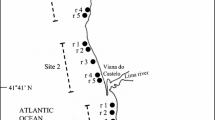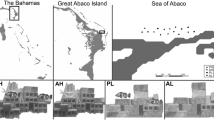Abstract
We tested the effect of reef complexity (number of small vs. large topographic elements,<1 m and >1 m, respectively), and composition of macroalgae (cover of the kelp Ecklonia radiata, fucalean and red algae) on the abundance patterns of labrid fishes across ~800 km of coastline in south-western Australia. Fishes and habitat attributes were visually counted at 12 reefs visited at four times over 1 year. Five labrids (Austrolabrus maculatus, Coris auricularis, Notolabrus parilus, Ophthalmolepis lineolata and Pseudolabrus biseralis) were frequently observed (>20% of counts), while three species (Bodianus axillaris, Choerodon rubescens and Thalassoma lutescens) were rarely censused (< 6%). Patterns of abundance were generally affected by two descriptors of the habitat structure: the number of small topographic elements (100 m−2), and the percentage of red algal cover. Most species showed a tendency for an increase in their abundances with an increase in the number of small topographic elements and cover of red algae. The patterns likely reflect an underlying correlation between habitat structure and prey accessibility and lowered predation risk.





Similar content being viewed by others
References
Anderson TW (1994) Role of macroalgal structure in the distribution and abundance of a temperate reef fish. Mar Ecol Prog Ser 113:279–290
Anderson MJ, Legendre P (1999) An empirical comparison of permutational methods for tests of partial regression coefficients in a linear model. J Stat Comp Sim 62:271–303
Anderson MJ, Millar RB (2004) Spatial variation and effects of habitat on temperate reef assemblages in north eastern New Zealand. J Exp Mar Biol Ecol 305(191):221
Choat JH, Ayling AM (1987) The relationship between habitat structure and fish faunas on New Zealand reefs. J Exp Mar Biol Ecol 110:257–284
Connell SD, Irving A (2008) Integrating ecology with biogeography using landscape characteristics: a case study of subtidal habitat across continental Australia. J Biogeogr 35:1608–1621
Denny CM (2005) Distribution and abundance of labrids in north-eastern New Zealand: the relationship between depth, exposure and pectoral fin aspect ratio. Environ Biol Fish 72:33–43
Denny CM, Schiel DR (2001) Feeding ecology of the banded wrasse Notolabrus fucicola (Labridae) in southern New Zealand: prey items, seasonal differences, and ontogenic variation. N Z J Mar Freshw Res 35:925–933
Ebeling AW, Hixon MA (1991) Tropical and temperate reef fishes: comparison of community structures. In: Sale PF (ed) The ecology of coral reef fishes. Academic, San Diego, pp 509–563
Ebeling AW, Laur DR (1985) The influence of plant cover on surfperch abundance at an offshore temperate reef. Environ Biol Fish 12:169–179
Edgar GH (2000) Australian marine life. New Holland Publishers, Sydney
Friedlander AM, Parrish JD (1998) Temporal dynamics of fish communities on an exposed shoreline in Hawaii. Environ Biol Fish 53:1–18
García-Charton JA, Pérez-Ruzafa A (1998) Correlation between habitat structure and rocky reef fish assemblages in SW Mediterranean. PSZNI Mar Ecol 19:111–128
García-Charton JA, Pérez-Ruzafa A (2001) Spatial pattern and the habitat structure of a Mediterranean rocky reef fish local assemblage. Mar Biol 138:917–934
Helfman GS, Collete BB, Facey DE (1997) The diversity of fishes. Blackwell Science, Massachusetts
Hixon MA, Beets JP (1993) Predation, prey refuges, and the structure of coral-reef fish assemblages. Ecol Monogr 63:77–101
Jones GP, Syms C (1998) Distribution, habitat structure and the ecology of fishes on coral reefs. Aust J Ecol 23:286–297
Kendrick GA (1999) Western Australia. In: Andrew A (ed) Under Southern Seas. University of New South Wales Press, Sydney
Kingsford M, Battershill C (1998) Studying marine temperate environments: a handbook for ecologists. Canterbury University Press, Christchurch
Kleczkowski M, Babcock RC, Clapin G (2008) Density and size of reef fishes in and around a temperate marine reserve. Mar Freshw Res 59:165–176
Kuffner IB, Brock JC, Grober-Dunsmore R, Bonito VE, Hickey TD, Wright CW (2007) Relationships between reef fish communities and remotely sensed rugosity measurements in Biscayne National Park, Florida, USA. Environ Biol Fish 78:71–82
Letourneur Y (1996) Dynamics of fish communities on Reunion fringing reefs, Indian Ocean. I. J Exp Mar Biol Ecol 195:1–30
Levin PS (1994) Small-scale variation in a temperate fish: the roles of macrophytes and food supply. Environ Biol Fish 26:29–37
Luckhurst BE, Luckhurst K (1978) Analysis of the influence of substrate variables on coral reef fish communities. Mar Biol 49:317–323
MacArthur LD, Hyndes GA (2007) Varying foraging strategies of Labridae in seagrass habitats: herbivory in temperate seagrass meadows? J Exp Mar Biol Ecol 340:247–258
Ordines F, Moranta J, Palmer M, Lerycke A, Suau A, Morales-Nin B, Grau AM (2005) Variations in a shallow rocky reef fish community at different spatial scales in the western Mediterranean Sea. Mar Ecol Prog Ser 304:221–233
Roberts DA, Poore AGB (2005) Habitat configuration affects colonization of epifauna in a marine algal bed. Biol Conserve 127:18–26
Samoilys MA, Carlos G (2000) Determining methods of underwater visual census for estimating the abundance of coral reef fishes. Environ Biol Fish 57:289–304
Tuya F, Wernberg T, Thomsen MS (2008) The spatial arrangement of reefs alters the ecological patterns of fauna between interspersed habitats. Estuar Coast Shelf Sci 78:774–782
Vanderklift MA, Kendrick GA (2004) Variation in abundances of herbivorous invertebrates in temperate subtidal rocky reef habitats. Mar Freshw Res 55:93–103
Wellenreuther M, Connell SD (2002) Response of predators to prey abundance: separating the effects of prey density and patch size. J Exp Mar Biol Ecol 273:61–71
Wernberg T, Kendrick GA, Phillips JC (2003) Regional differences in kelp-associated algal assemblages on temperate limestone reefs in south-western Australia. Divers Distrib 9:427–441
Wernberg T, Kendrick GA, Toohey BD (2005) Modification of the physical environment by an Ecklonia radiata (Laminariales) canopy and implications for associated foliose algae. Aquat Ecol 39:419–430
Wernberg T, Thomsen MS, Tuya F, Kendrick GA, Staehr P, Toohey B (2009) Global warming is eroding the resilience of kelp beds. Global Chan Biol (under review)
Willis TR, Anderson MJ (2003) Structure of cryptic reef fish assemblages: relationships with habitat characteristics and predator density. Mar Ecol Prog Ser 257:209–221
Acknowledgements
This research was funded by an Australian Research Council Discovery grant (DP0555929) to Thomas Wernberg. Fernando Tuya was supported by a postdoctoral research fellowship within the framework ‘Plan de Formación y Perfeccionamiento’ of the Spanish Ministry of Education and Sciences, and Mads. S. Thomsen was supported by a postdoctoral fellowship from The Danish Research Academy. Four anonymous reviewers provided positive comments on previous drafts.
Author information
Authors and Affiliations
Corresponding author
Rights and permissions
About this article
Cite this article
Tuya, F., Wernberg, T. & Thomsen, M.S. Habitat structure affect abundances of labrid fishes across temperate reefs in south-western Australia. Environ Biol Fish 86, 311–319 (2009). https://doi.org/10.1007/s10641-009-9520-5
Received:
Accepted:
Published:
Issue Date:
DOI: https://doi.org/10.1007/s10641-009-9520-5




